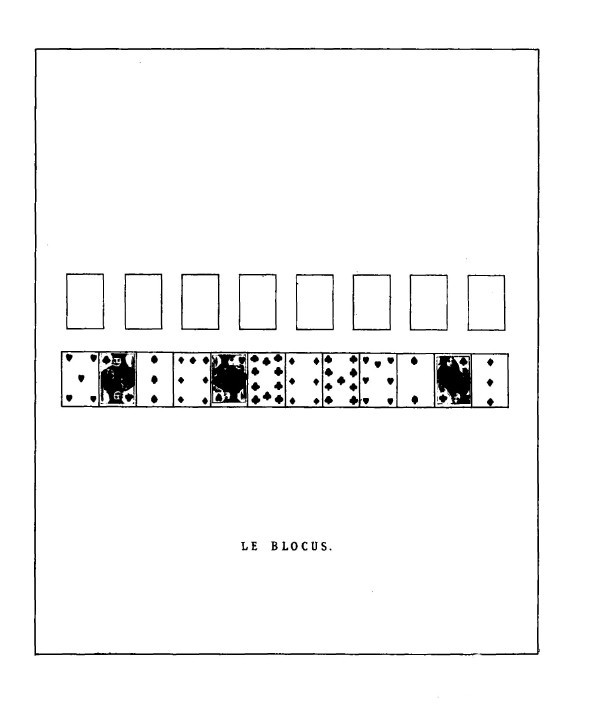
LE
BLOCUS.
TWO
ENTIRE PACKS OF CARDS.
RULES.
I.
ALL cards in the first row are available, but as each row is placed
it blocks the preceding one.
The
removal of any card in the lower rows releases the one immediately
above it, the principle being that all cards are available that have
no others below them.
II.
The foundations must follow suit.
PLAY.
Deal
out twelve cards in a horizontal line. Aces may be played as they
appear, but no other card can be played until the row is complete.
The eight aces are the foundation cards, and are to ascend in
sequence to kings.
When
the first line is placed, play any suitable cards, and then marry in
descending line, but be careful to place the cards exactly over each
other, to avoid confusion. The vacancies thus caused must be
immediately
re-filled from the pack, then again play and marry. When neither can
be done, deal out another row underneath the first, and when it is
complete, play, marry and refill spaces as before.
You
continue to deal out successive rows until the pack is exhausted,
always pausing between each row to play, marry and re-fill spaces.
In
the course of the game vacancies will often be made in the higher
rows. These must always be re-filled first.
There
is no re-deal.
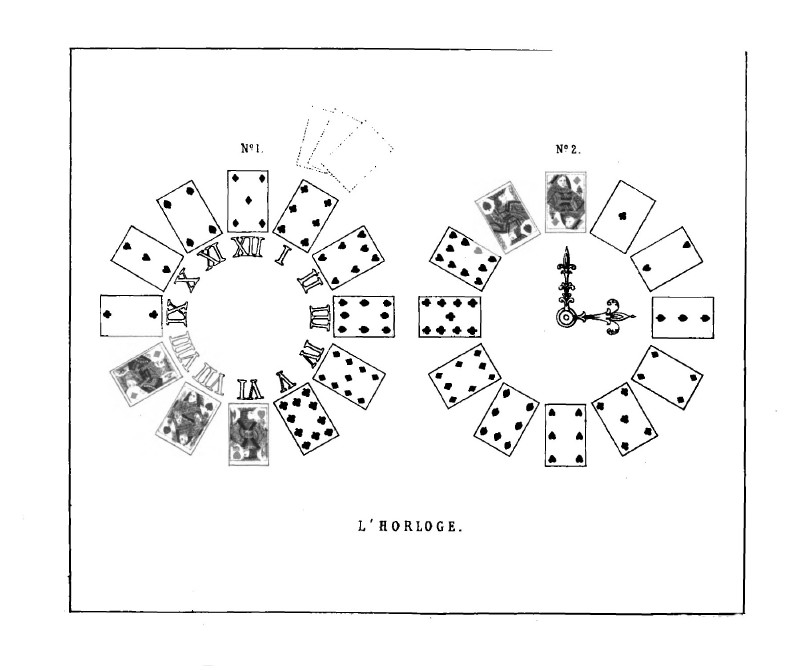 L'HORLOGE. L'HORLOGE.
TWO
ENTIRE PACKS OF CARDS.
RULES.
I.
WHEN the circle is formed, the uppermost cards of each packet are
available, and their removal releases as usual those beneath.
II.
Marriages can only be made with cards in the circle, and not with
those from the pack or talon.
III.
Vacancies in the circle must be re-filled with cards from the pack,
but not from the talon; each packet must be re-filled so as to
contain not less than three cards.
IV.
The twelve foundations must follow suit.
PLAY.
Withdraw
from the pack the twelve cards, as in tableau No. I., and place them
in their exact order against the hours of the clock represented.
These are the foundation cards, and are to ascend in sequence until
each packet attains the hour of the clock against which it is placed.
Having
placed these twelve foundations, proceed to deal out a circle
consisting of twelve packets of three cards dealt together — so
spread that each card is visible (see dotted line). From this circle
you first play all suitable cards (Rule I.), and then marry in a
descending line (Rule II.), and then re-fill spaces (Rule III.). This
last should be done in order, from left to right, beginning at the
numeral t, and all the packets refilled before proceeding again to
play, or to marry.
Note.--Although
each packet must never contain less than the original number of three
cards, they will often, by marriages, contain more.
You
are not obliged to play cards which would be more useful if left on
the circle.
When
all further progress is at an end, deal out the remaining cards; play
all suitable ones, then marry and re-fill spaces, but be careful not
to infringe Rule II.
The
cards that cannot be so employed are laid aside in one packet,
forming the talon, which can only be used to play on the foundations.
There is no re-deal.
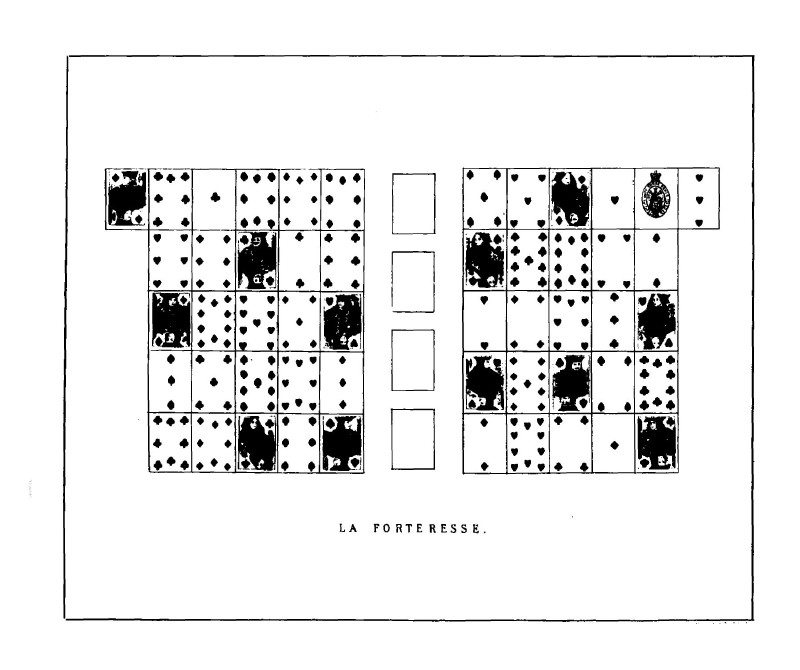
LA
FORTERESSE.
ONE
ENTIRE PACK OF CARDS.
RULES.
I.
ONLY the outside cards of each group are available, until by their
removal the next ones are released, the principle being that no-card
can be used that has another outside it.
Note.
— By "outside" is meant the cards on the right side of
the right hand group, and those on the left side of the left hand
group.
II.
The foundations must follow suit.
PLAY.
Deal
out the entire pack horizontally in two groups, as in tableau,
beginning at the left hand, and dealing straight across each group,
leaving space in the centre for four aces. These, when they can be
played, form the foundation cards, and are to ascend in sequence to
kings.
Should
any aces appear on the outside of either group, play them, as also
any other suitable cards for continuing the foundations (Rules I. and
II.).
You
next proceed to form marriages, both in ascending and in descending
lines, with cards on the outside of both groups (Rule I.). But this
must be done with extreme care, so as not only to release the
greatest number of suitable cards, but also, if possible, to open out
one entire horizontal row of cards to form a lane. The success of the
game entirely depends on these lanes. If, therefore, you succeed in
opening out one, it is more prudent not to re-fill it, until by some
fresh combination others can be made.
When
a lane is to be re-filled, select any available card (Rule I.), and
place it at the inner end of the lane, and along it any others in
sequence of the same suit, the last card being of course the
available one. One great use of these lanes is, to reverse any
sequences that have been made by marriages in the ascending line.
Note
— Supposing you have placed upon a deuce a sequence ending with
eight; place the eight at the inner end of the lane, the other cards
following in succession till the deuce becomes the outside card. When
there are more cards in the lane than the original number they can be
placed partly over each other.
There
is no re-deal.
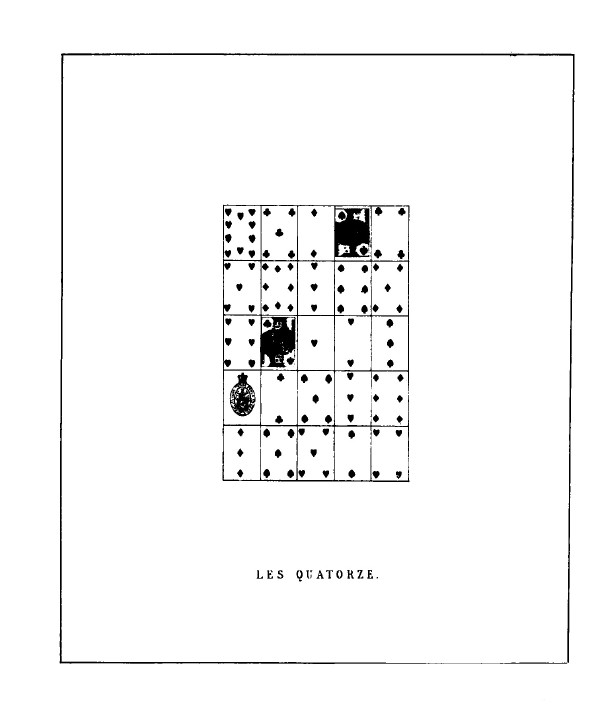
LES
QUATORZE.
TWO
ENTIRE PACKS OF CARDS.
PLAY.
DEAL
out twenty-five cards in five rows, each containing five cards. The
object is to compose the number fourteen with any two cards taken
either from a perpendicular or from a horizontal row. The knave
counts eleven, the queen twelve, and the king thirteen.
The
cards so paired are withdrawn, and their places filled by the cards
in your hand.
If
in the course of the game the number fourteen cannot be composed,
one chance remains.---any two cards may be taken from their proper
position, and may change places with any other two cards, and it is
only in making this exchange, so as to produce one or more fourteens,
that the player has any control over the success of the game, the
success consisting of the entire pack being paired off. In the
tableau three fourteens could be at once composed : The ten of hearts
with the four of clubs, the knave of spades with the three of hearts,
the eight of diamonds with the six of spades.
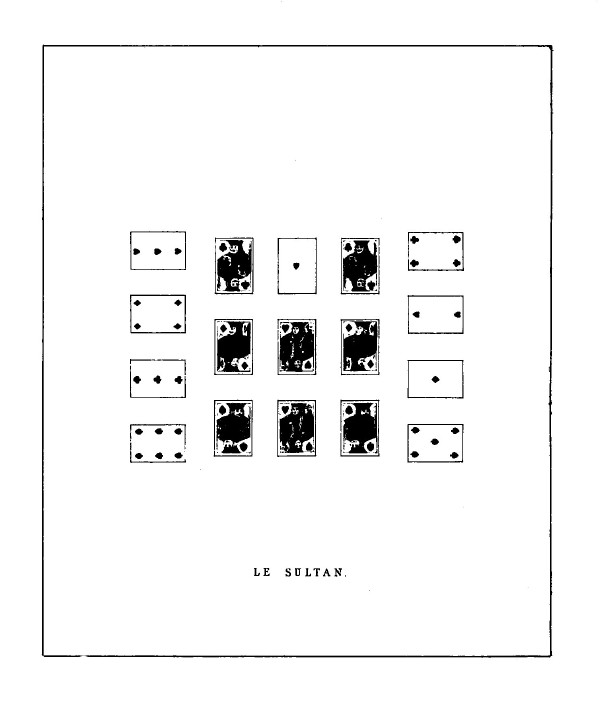
LE
SULTAN.
TWO
ENTIRE PACKS OF CARDS.
RULE.
THE
foundations must follow suit.
PLAY.
Withdraw
from the pack and place the eight kings and one ace of hearts as in
tableau.
The
centre king of hearts is called the Sultan, and remains alone. The
other seven kings, with the ace of hearts, form the foundation cards.
Each of these seven kings begins with ace, and ascends in sequence to
queen. The ace of hearts ascends in the same manner, so that all the
eight packets surrounding the Sultan end with queens.
You
next deal out eight cards, four on either side (see tableau). These
constitute the Divan. From this Divan you can play any suitable cards
on the foundations, and having done so, proceed to deal out the
remainder of the pack, turning the cards one by one, those that are
not suitable for the foundations being laid aside in one packet
forming the talon. Vacancies in the divan must be immediately
re-filled from the talon, or when there is no talon, from the pack.
The
talon may be taken up, shuffled and re-dealt if necessary twice.
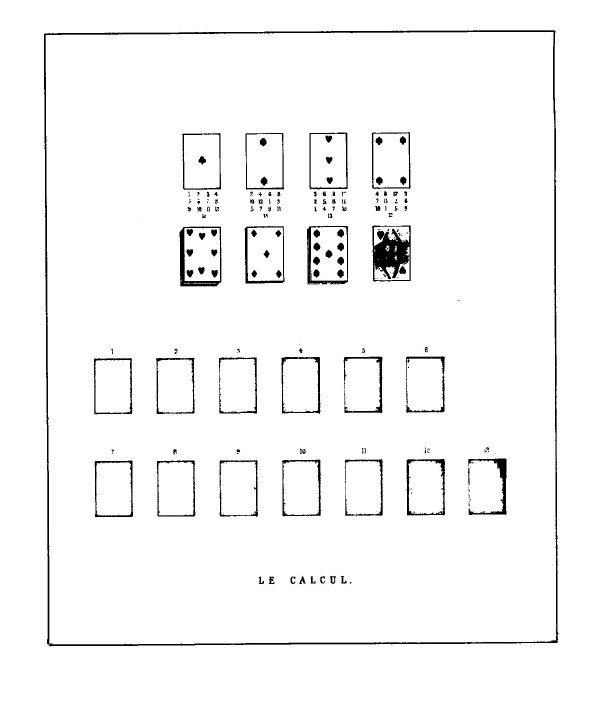
LE
CALCUL.
ONE
ENTIRE PACK OF CARDS.
RULES.
I.
THE foundations do not follow suit.
II.
The talon may consist of four packets arranged at the player's
discretion; but only the uppermost card of each is available, until
those underneath are released in the usual manner.
PLAY.
Withdraw
from the pack any ace, deuce, three, and four, and place them in a
row, as in tableau. These are the foundation cards. The first or ace
packet ascends in the usual sequence to king; the second packet
ascends by twos, the third by threes, the fourth by fours — all the
four packets terminating alike with kings.
In
counting, the knave is reckoned as eleven, the queen as twelve, and
the king as thirteen.
When,
in forming the foundations, the number thirteen is passed (for it is
never attained till it finishes each packet), the ace counts
fourteen, the deuce fifteen, and so on. For example, in forming the
second packet, when the number twelve or queen is reached, the next
number required being fourteen, it is represented by ace, sixteen by
three, and so on. This is difficult to describe, but may be
understood by the numbers written on the tableau.
Having
placed the foundations, deal out the cards in your hand, turning them
one by one, playing all that are suitable on the foundations, the
rest forming the talon (Rule II.).
On
the judicious placing of this talon the success of the game depends,
and a little practice is needed, to remember which cards will be
required first, and to arrange the talon accordingly, for a card once
placed cannot be transferred from one packet to another. The kings
being wanted only to finish each foundation, it is advantageous to
leave one packet for a time free to receive them; and, in forming the
other packets, to avoid, as long as possible, covering the cards
required first with those that will only be wanted later.
Note.
— Some players wait, to place the foundation cards, until they
appear in the course of the deal. This renders the game more
interesting, but also more difficult, and in this manner it seldom
succeeds.
There
is no re-deal.
If
this game should succeed, a sequel to it may be made as follows
:Take up the four foundation packets in order, placing the
fourth on the third, the third on the second, and the second on the
first, so that, on turning the cards to deal, the ace packet is
uppermost.
Deal
out thirteen cards in two horizontal rows, face downwards (see
tableau, second part). Next deal a second round, beginning on the
second card and continuing on every alternate card till all are
covered; next deal a third round, beginning on the third, and
continuing on every third card; next a fourth round beginning on the
fourth, and continuing on every fourth card, each round, finishing on
the thirteenth card.
Then
turn the packets, and the cards will be found arranged, all of the
same value together — four aces, four deuces, &c.
Note. — In the pattern tableau, No. I, all
the talon packets are
represented as being established, but before that was done some of
the foundations would probably have been already begun. The eight and
the queen would at any rate have been played on the fourth
foundation.
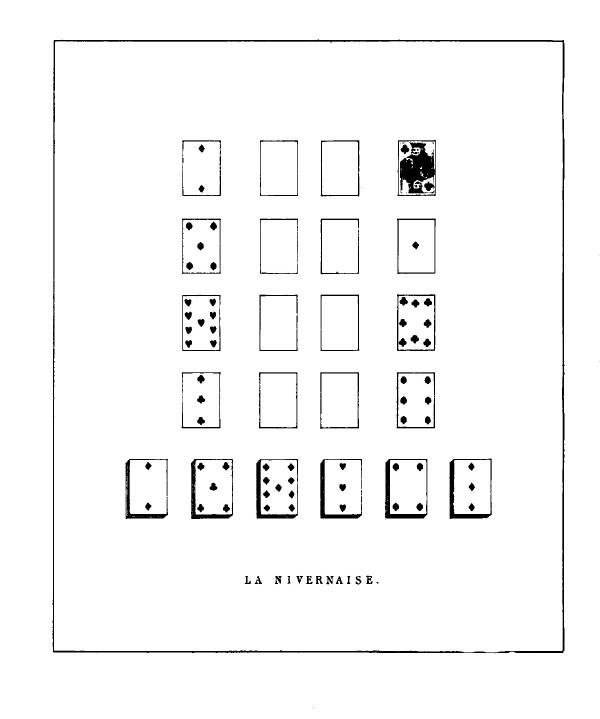
LA
NIVERNAISE.
TWO
ENTIRE PACKS OF CARDS.
RULES.
I.
THE Line is to consist of six packets, of which the uppermost card of
each is alone available, until by its removal the one beneath is
released — the card which is uppermost at the time being always the
available one.
II.
As many cards in each of the packets forming the Line may be examined
as there are vacancies in the Flanks.
III.
All the foundations must follow suit.
IV.
In re-dealing, the Line packets must be taken up in succession,
beginning on the left; then the whole together turned, and re-dealt
as before.
PLAY.
Place
two perpendicular rows of four cards each, called Flanks, leaving
space in the centre for four aces and four kings of different suits.
These, when they can be played, form the foundation cards, the kings
descending in sequence to aces, the aces ascending in sequence to
kings.
You
next deal from left to right six packets, each composed of four cards
dealt together, and placed in a horizontal line underneath. These
packets are called the Line, and will receive successive additions.
If
any of the foundation cards appear on the surface of the Line, or on
the Flanks, play them in the spaces reserved; as also any other
suitable cards subject to Rule I., taking, however, in preference,
cards from the flanks, as the vacancies so made are most important.
Note.
— So necessary to success are these vacancies that, if after
dealing the first round of the Line none have been made, it is
scarcely worth while to continue the game.
They
may be filled from the pack or from the Line, but it is never prudent
to fill up all vacancies; one at least should be left.
Single
cards are not to be replaced on the Line; but if an entire packet has
been played off, four more cards are to be immediately placed in its
stead, and this rule applies to each several round.
When
the resources thus far are exhausted, deal a second round of four
cards together, on each of the Line packets as before, and continue
thus to deal successive rounds until all the cards are dealt out, but
between each round pause, and examine the Line (Rule II.) and the
Flanks, and play all available cards.
The
whole of the pack having been dealt, and further progress at an end,
take up the Line as prescribed in Rule IV., re-deal, and play exactly
as at first.
There
is only one re-deal.
In
forming the foundations, one card at a time may be exchanged from the
ascending to the descending sequences, and vice versâ.
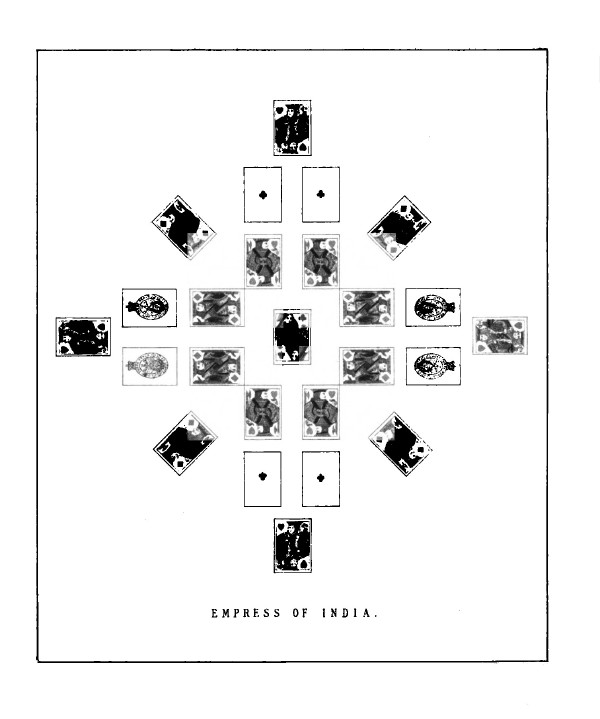
THE
EMPRESS OF INDIA.
FOUR
ENTIRE PACKS OF CARDS.
RULES.
I.
ALL cards in the Army and Navy are equally available, if played in
pairs i. e. one black and one red), but no card of either colour can
be played on a foundation unless a card of the other colour is played
at the same time on another foundation.
II.
Vacancies in the Army and Navy must be immediately re-filled with
cards of their own colour from the talon, or when there is no talon,
from the pack.
III.
Cards from the pack or talon cannot be played at once, but must first
pass through the Army or Navy.
IV.
The talon consists of two packets, one of red, the other of black
cards.
V.
The foundations must follow suit.
PLAY.
Withdraw
from the pack the eight black aces and the eight black queens, the
eight red kings and the eight red knaves.
Place
these cards as in the tableau, throwing aside the four queens of
spades and three queens of clubs.
The
remaining queen of clubs represents the Empress, the knaves the guard
of British soldiers, and these nine cards remain alone.
The
eight black aces and the eight red kings are the foundation cards,
the aces ascending in sequence to kings, representing Admirals, the
kings descending in sequence to aces, representing Generals.
Note.
— The red sequences must omit knaves, the black ones must omit
queens.
Deal
out four horizontal rows, each containing twelve cards, of which the
two upper rows are to be red (the Army), the two lower ones black
(the Navy).
They
are to be dealt at the same time, and if after the two rows of one
colour, say red, are finished, more red cards turn up, they must be
laid aside as a talon (Rule IV.).
When
the Army and Navy are complete, if any available pairs of cards have
been dealt (Rule I.) play them (the first pair must of course be a
black two and a red queen), and re-fill the spaces; but if there
should be none, you may proceed to pair cards. Any card in the Army
may be placed on any card in the Navy, and vice versa, but the cards
so paired cannot afterwards be separated, but must be played at the
same time on their respective foundations. The vacancies thus made
must be immediately re-filled (Rule II.).
Each
card can only be paired once.
You
may choose your own time for pairing cards. For instance, if you
require say a ten of clubs for one of the foundations you may defer
making a vacancy in the Navy until the ten of clubs is at the top of
the talon. When you have played all available cards, deal out the
remainder of the pack, those not required to fill vacancies being
placed in two packets (Rule IV.).
There
is no re-deal.
Note.
— The Army and Navy could not be placed in the tableau from want of
space.
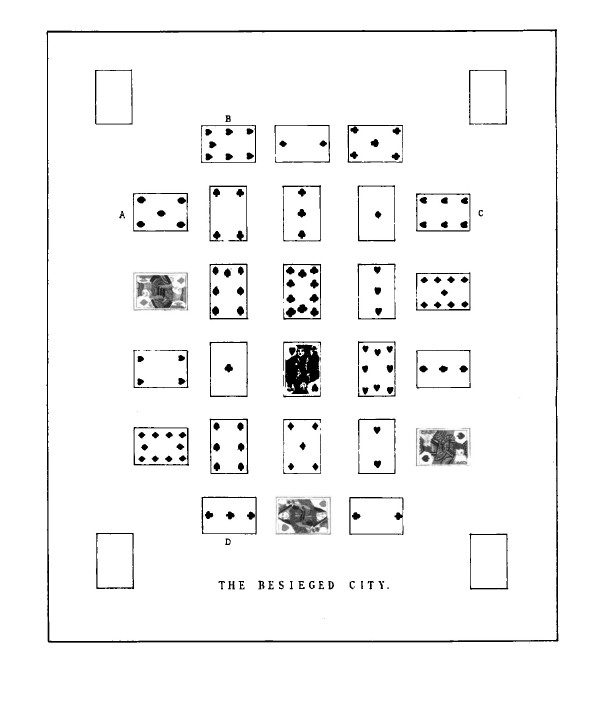
THE
BESIEGED CITY.
TWO
ENTIRE PACKS OF CARDS.
RULES.
I.
THE foundations are formed with cards from the Ramparts and from the
pack. Cards from the talon must pass through the Reserve, and the
Reserve must pass into the Ramparts before they can be played.
II.
Cards in the Ramparts may be placed on each other either in the usual
ascending and descending sequences, or in the order in which they
will be played, viz. queen on two, knave on three, and so on, or vice
versa. They must be of the same suit; and sequences, both in
ascending and in descending lines, may be placed in the same packet.
Cards
in the Ramparts may be transferred from one packet to another at
discretion (the top card of each being alone available), and they
must follow suit.
III.
Cards in the Reserve may in the same way be placed on those in the
Ramparts, but only on the cards at the ends or sides of the line from
which they are taken.
Note.
— In the tableau the four of clubs could only be placed on cards at
A, B, C, or D, and in this case only on D.
IV.
Vacancies in the Ramparts are filled from the Reserve, with any card
in the row at the end of which the vacancy occurs.
Note.
— In the tableau a vacancy at B or D could only be filled by the
four or ace of clubs, or by the seven or six of spades; and a vacancy
at A or C, by the ace of diamonds or by the three or four of clubs.
V.
Vacancies in the Reserve are filled from the talon, or when there is
no talon, from the pack.
VI.
The foundations must follow suit.
PLAY.
Deal
twelve cards in four rows of three cards each. Then deal an outside
row of fourteen cards placed crossways. These are the "Ramparts."
The inside twelve cards are the "Reserve."
The
foundation cards are four aces of different suits. On these are
placed kings, then deuces, queens, threes and so on, each foundation
consisting of alternate sequences, ascending and descending, and
finishing as well as beginning with aces (Rule VI.).
Having
placed the tableau, take from the Ramparts aces or other suitable
cards (if any have been dealt) and play them in their allotted
places, immediately filling each vacancy as it occurs (Rules IV. and
V.); this must be done throughout the game. Then transfer cards in
the Ramparts, and from the Reserve, as directed in Rules II. and III.
When
you have done all that you wish (for it is optional), and again
played if you can, deal out the remainder of the pack, the cards not
suitable for the foundations being placed in a talon.
At
the end of the patience, when the talon is exhausted and all the
cards have been dealt, should there still be cards in the Reserve
which cannot be transferred to the Ramparts, you may transpose them
to effect this if you can.
This
patience is exceedingly difficult.
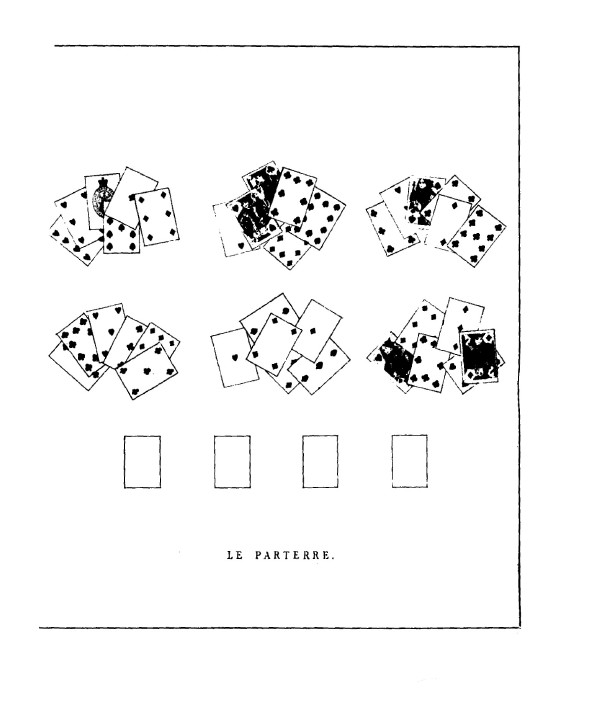
LE
PARTERRE.
ONE
ENTIRE PACK OF CARDS.
RULES.
I.
ANY card in the Bouquet and the uppermost cards of the Parterre are
available. The removal of the top cards releases those beneath.
II.
The foundations must follow suit.
III.
Cards placed in sequence on the Parterre need not follow suit.
PLAY.
Deal
six packets of six cards dealt together, and so spread that all are
visible. The four aces are the foundation cards, and are to ascend in
sequence to kings (Rule II.).
Sixteen
cards will remain, which are called the Bouquet, and must be kept in
the hand. Take from the Bouquet and from the Parterre any aces or
other suitable cards (Rule I.) and play them.
Next
place cards in descending sequences in the Parterre, transferring
them from one packet to another as often as you please (Rules I. and
III.), and you may place cards from the Bouquet in the same way.
For
example, place the four of diamonds (see tableau) on the five of
clubs, then take the ten of hearts from the Bouquet and place it on
the knave of diamonds. The nine of clubs can now be transferred, and
the ace and deuce of diamonds are released.
This
patience is exceedingly difficult. Cards taken from the Bouquet
cannot be returned to it, and there is only one deal. The greatest
care must therefore be taken in placing cards in sequence and in
playing them. You are not obliged to do either, and it is often
better to leave a card than to play it, as it may be useful in
releasing others.
When
an entire packet is cleared off you may begin a new one with a card
from the Bouquet or from the Parterre (Rule I.), and this is often
the only means of removing a king, which, being the highest card, can
never be transferred.
|

